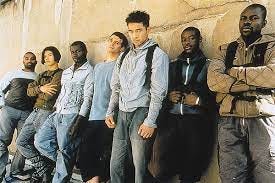You sure thought wrong if you believed this series was going to be discontinued🌝. I wouldn’t blame you though, it certainly looked like it was kaput. Long story short sha, we are back with a bang!!!
I randomly came across this sport while looking for more deets on street luging. This looked more perilous🤧. With the name seeming kinda exotic, I just had to delve in😁. It seems uncommon but that might be because of its media novelty. Its been quite famous in Europe and currently gaining more attention in the United States.
Visualizing it though, it seems like something people could be familiar with, without knowing it as parkour. It’s simply a jump over obstacles, like an extended version of a hurdle race. This might make it seem like it could be practiced easily by amateurs sef with easy creation of the dangerous stunts. I wouldn’t advise that though. Wanna know why? Let’s dig in😊.
Per Wikipedia, Parkour is a training discipline where practitioners (called traceurs) move from one place to another in a complex environment, without assisting equipment and in the fastest and most efficient way possible. These traceurs have a goal to overcome obstacles either by running, climbing, swinging, vaulting, jumping, plyometrics, rolling, or quadrupedal movement.
Where does it come from?
Definitely, this sport didn’t emerge all of a sudden. It originated from somewhere, that being the physical education and training methods, known as “la méthode naturelle.” which commenced in the years before World War I by Georges Hébert. It was however popularized by David Belle who was frustrated with normal school sports and wanted something different. He wanted to practice sports with useful life hack skills not just the wonted sports in safe vicinities.
This led to learning about Parcours from his father, a Parisian firefighter, and training with this philosophy. As teenagers, Belle and his friends from the Yamakasi (the first created group of traceurs) practised jumping, climbing over stairs, barriers, walls, etc in his city. They had strict rules for training and everyone equally participated in the challenges. Doing so, they made up the art of moving, capitalizing on constructions and obstacles not originally created for this purpose.
How is Parkour good for you?
You know I wouldn’t advise you to just jump into something without making extremely sure that you could gain from it😌. Here are some benefits of doing parkour:
Uplifts confidence – A personal favourite for me would be the way Parkour could help bolster one’s confidence. This is usually through its allowing traceurs to be able to surmount feats that they had erstwhile thought impossible. That knowledge makes them feel like they could learn how to scale through a tough grind, once they are dedicated and determined to do that. One could also defeat fear and depression with every jump and parkour move.
Parkour training increases bone and joint strength as the impact one takes from doing it will put force on the bones, in essence making it strong enough to prevent fractures. Due to the many movements in parkour training, a traceur develops a strong core, with increased agility.
A fun benefit would be the fact that you could make daily and humdrum tasks look like spectacular movie scenes. Your usual walking on the steps could seem fancier if you just put a little perk of parkour. Though popular media scenes make it seem like parkour could only involve extremely difficult moves, one can easily learn some of the moves as they come from simple movements. The difficulty range just differs.
Encourages quick-thinking skills – Parkour requires participants to negotiate obstacles quickly. Most parkour movements in nature demand traceurs to think fast about the obstacles using logic and careful deductions which could also help their daily living. So, you are thinking on your feet and also exercising your brain.
Risks in Parkour
It does seem easy and fun-like, yeah?? Don’t even think about it. There is a reason it was called an extreme sport and advised for people that are extremely skilled in performing stunts. If this ain’t you, look away fast abeg.
Most traceurs tend to use private locations when practicing parkour, which could lead to property damage and fines. Apparently, it even became illegal in some places such as airports, train stations, government and business buildings, and malls to avoid properties damage and stories that touch.
Doing parkour could cause extreme personal injuries from a wrong landing, falling from a high place, or flunking a move. There is a high risk of death if one is not extremely careful. One also has to constantly practise more dangerous stunts in order to get better and more skilled.
Again, if you are just doing this because of social media validation, just halt!!!
That being said, I wish I could effectively parkour my newsletter not earning revenue😫.
Lemme at least land safely with more followers😋😋.





Even if you do not consider it parkour, my friends and I were tranceurs growing up ourselves. We used to scale walls and jump from distance higher than ourselves
Do you know how many incidents of bone breakage was recorded from "baba mi ko le bẹ" and other "extreme" parkour movements?
Mtcheew! What's in parkour that we can't do??
Emi tranceur fun ra mi!
Welcome back jare, ma'am
More grease to your elbow